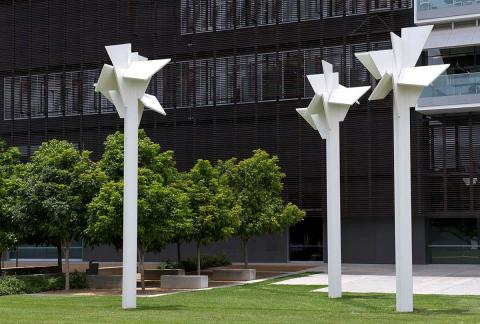Martin Boyce: We are shipwrecked and landlocked
By Nicholas Chambers
May 2010
Martin Boyce works predominantly as a sculptor and is primarily concerned with a reworking and reimagining of classical modernist forms. Public spaces are often an important reference point in his works and he aims to investigate the manner in which their design, both through landscaping and architecture, shapes our shared experience of space and impacts upon us psychologically. His outdoor works create subtle shifts in our relationship to the given site, drawing our attention to the relationship between natural and constructed elements.
We are shipwrecked and landlocked is a major public art work by Boyce that was commissioned by Kaldor Art Projects. It was first exhibited in the Alumni Courtyard at the Royal Melbourne Institute of Technology (RMIT) in October 2008. The central components of the installation at RMIT, three 770cm-tall aluminium ‘trees’, were gifted to the Gallery by John Kaldor, the artist and the Modern Institute (the artist’s gallery in Glasgow).
The tree forms are inspired by a photograph depicting a group of concrete trees designed by Joël and Jan Martel in 1925. Created for the International Exhibition of Decorative and Industrial Arts in Paris, the Martels’ trees were displayed in the garden of influential French architect Robert Mallet-Stevens and destroyed soon after the exhibition.
According to Boyce, the trees ‘represent a perfect collapse of architecture and nature’. Constructed using industrial materials and based on a form which was in turn abstracted from nature, Boyce’s sculpture reflects contrasting forces in the urban landscape: natural versus constructed, populated versus uninhabited, old versus new.
Boyce has installed versions of the Martels’ trees in a range of different environments, including a fifteenth-century Venetian palace, gallery exhibitions in Zurich and Edinburgh, and at the RMIT. Estranged from their original 1925 context, the trees are like characters which the artist casts in different locations, each one suggesting a new narrative.

